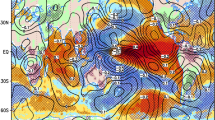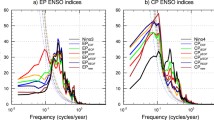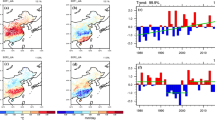Abstract
The suggestion that there exist two types of El Niño in the tropical Pacific has generated a debate in the community. Applying various linear and non-linear approaches and composite analysis technique on observed and reanalyzed climate datasets primarily for the 1950–2010 period, we revisit the variability of the tropical Pacific in the light of this debate. Our objective is to examine whether the proposed El Niño Modokis need a classification distinct from canonical El Niños. Even if the distinction is subject to short data records, we demonstrate that the El Niño Modoki events indeed display a seasonal evolution and teleconnections different from the canonical El Niños, and that the distinction is not subject to inclusion of the two extreme El Niños 1982 and 1997 as canonical El Niños. We show that the El Niño Modoki events are not an artifact associated with the orthogonality constraint associated with the EOF technique. Our cluster analysis shows that evolutions of the canonical El Niño and El Niño Modokis through various seasons differ from one another. Importantly, the dynamic and thermodynamic air–sea coupling strength is distinctly different between the El Niño Modoki and the canonical El Niño events. We find that, dynamic feedback intensity is stronger for El Niño Modoki (canonical El Niño) during boreal summer (winter); though the air–sea coupling strength, a major contributor to Bjerknes feedback, is maximum for Modokis during the developing stages, it decreases thereafter. In case of thermodynamic feedback intensity, SST-wind-evaporation feedback is dominant for El Niños while SST-SHF feedback is important during El Niño Modokis. However, we find that the thermodynamic feedback values significantly differ across the flux datasets.







Similar content being viewed by others
References
Aceituno P (1988) On the functioning of the southern oscillation in the south american sector. Part I: surface climate. Mon Wea Rev 116:505–524
An S-I, Jin F-F (2004) Nonlinearity and asymmetry of ENSO*. J Clim 17:2399–2412
Ashok K, Saji NH (2007) On the impacts of ENSO and Indian Ocean dipole events on the sub-regional Indian summer monsoon rainfall. J Nat Hazards. doi:10.1007/s11069-006-9091-0
Ashok K, Behera S, Rao SA, Weng H, Yamagata T (2007) El Niño Modoki and its possible teleconnection. J Geophys Res 112:C11007. doi:10.1029/2006JC003798
Ashok K, Tam C-Y, Lee W-J (2009) ENSO Modoki impact on the Southern Hemisphere storm track activity during extended austral winter. Geophys Res Lett 36:L12705. doi:10.1029/2009GL038847
Ashok K, Sabin TP, Swapna P, Murtugudde RG (2012) Is a global warming signature emerging in the tropical Pacific? Geophys Res Lett 39:L02701. doi:10.1029/2011GL050232
Ashok K, Nagaraju C, Sengupta A, Pai S (2014) Decadal Changes in the relationship between the Indian and Australian summer monsoons. Clim Dyn. doi:10.1007/s00382-012-1625-4
Balmaseda MA, Mogensen K, Weaver AT (2013) Evaluation of the ECMWF ocean reanalysis system ORAS4. QJR Meteorol Soc 139:1132–1161. doi:10.1002/qj.2063
Behera S, Yamagata T (2010) Imprint of the El Niño Modoki on decadal sea level changes. Geophys Res Lett 37:L23702. doi:10.1029/2010GL045936
Behera SK, Rao SA, Saji HN, Yamagata T (2003) Comments on “a cautionary note on the interpretation of EOFs”. J Clim 16:1087–1093
Bejarano L, Jin FF (2008) Coexistence of equatorial coupled modes of ENSO*. J Clim 21:3051–3067
Bjerknes J (1969) Atmospheric teleconnections from the equatorial Pacific. Mon Wea Rev 97:163–172
Cai W, Cowan T (2009) La Nina Modoki impacts Australia autumn rainfall variability. Geophys Res Lett 36:L12805. doi:10.1029/2009GL037885
Capotondi A et al (2014) Understanding ENSO diversity. Bull Am Meteorol Soc. doi:10.1175/BAMS-D-13-00117.1
Carton JA, Giese BS (2008) A reanalysis of ocean climate using simple ocean data assimilation (SODA). Mon Wea Rev 136:2999–3017
Chen G, Tam C-Y (2010) Different impact of two kinds of Pacific Ocean warming on tropical cyclone frequency over western North Pacific. Geophys Res Lett 37:L01803. doi:10.1029/2009GL041708
Cleveland RB, Cleveland WS, McRae JE, Terpenning I (1990) STL: a seasonal-trend decomposition procedure based on loess. J Off Stat 6(1):3–73
Dee DP et al (2011) The ERA-Interim reanalysis: configuration and performance of the data assimilation system. Q J R Meteorol Soc 137:553–597. doi:10.1002/qj.828
Deser C, Phillips AS, Hurrell JW (2004) Pacific interdecadal climate variability: linkages between the tropics and the north Pacific during boreal winter since 1900. J Clim 17:3109–3124
Diaz HF, Hoerling MP, Eischeid JK (2001) ENSO variability, teleconnections and climate change. Int J Climatol 21:1845–1862. doi:10.1002/joc.631
Dommenget D, Latif M (2002) A cautionary note on the interpretation of EOFs. J Clim 15:216–225. doi:10.1175/1520-0442(2002)015<0216:ACNOTI>2.0.CO;2
Donguy JR, Dessier A (1983) El Niño-like events observed in the tropical Pacific. Mon Wea Rev 111:2136–2139. doi:10.1175/1520-0442(2002)015<0216:ACNOTI>2.0.CO;2
Endo H, Kitoh A, Ose T, Mizuta R, Kusunoki S (2012) Future changes and uncertainties in Asian precipitation simulated by multiphysics and multi–sea surface temperature ensemble experiments with high-resolution meteorological research institute atmospheric general circulation models (MRI-AGCMs). J Geophys Res 117(D16118):668. doi:10.1029/2012JD017874.31
Gierach MM, Lee T, Turk D, McPhaden MJ (2012) Biological response to the1997–1998 and 2009–2010 El Niño events in the equatorial Pacific Ocean. Geophys Res Lett 39:L10602. doi:10.1029/2012GL051103
Giese BS, Ray S (2011) El Niño variability in simple ocean data assimilation (SODA), 1871–2008. J Geophys Res 116:C02024. doi:10.1029/2010JC006695
Guilyardi E, Pascale B, Jin F-F, Kim ST, Kolasinski M, Li T, Musat I (2009) Atmosphere feedbacks during ENSO in a Coupled GCM with a modified atmospheric convection scheme. J Clim 22:5698–5718
Hendon HH, Lim E, Wang G, Alves O, Hudson D (2009) Prospects for predicting two flavors of El Niño. Geophys Res Lett 36:L19713. doi:10.1029/2009GL040100
Jeong HI et al (2012) Assessment of the APCC coupled MME suite in predicting the distinctive climate impacts of two types of ENSO during boreal winter. Clim Dyn. doi:10.1007/s00382-012-1359-3
Jin F-F, Kim ST, Bejarano L (2006) A coupled-stability index for ENSO. Geophys Res Lett 33:L23708. doi:10.1029/2006GL027221
Johnson NC (2013) How many ENSO flavors can we distinguish? J Clim 26:4816–4827
Jolliffe IT (1989a) Rotation of principal components: choice of normalization constraint. J Appl Stat 22(42813):1989
Jolliffe IT (1989b) Rotation of ill-defined principal components. Appl Stat 38:139–147
Kalnay E et al (1996) The NCEP/NCAR 40-year reanalysis project. Bull Am Meteor Soc 77:437–471
Kao HY, Yu JY (2009) Contrasting Eastern-Pacific and Central-Pacific types of ENSO. J Clim 22:615–632. doi:10.1175/2008JCLI2309.1
Keshavamurty RN (1982) Response of the atmosphere to sea surface temperature anomalies over the equatorial Pacific and the teleconnections of the Southern oscillation. J Atmos Sci 39:1241–1259. doi:10.1175/1520469(1982)039<1241:ROTATS>2.0.CO;2
Kim TK, Jin FF (2011) An ENSO stability analysis. Part II: results from the twentieth and twenty-first centuary simulations of the CMIP3 models. Clim Dyn 36:1609–1627. doi:10.1007/s00382-010-0872-5
Kim HM, Webster PJ, Judith AC (2009) Impact of shifting patterns of pacific ocean warming on north atlantic tropical cyclones. Science. doi:10.1126/science.1174062
Kim DW, Choi KS, Byun HR (2012a) Effects of El Niño Modoki on winter precipitation in Korea. Clim Dyn 38:1313–1324. doi:10.1007/s00382-011-1114-1
Kim JS, Kim KY, Yeh SW (2012b) Statistical evidence for the natural variation of the central Pacific El Niño. J Geophys Res 117:C06014. doi:10.1029/2012JC008003
Kug JS, Jin F-F, An SI (2009) Two types of El Niño events: cold tongue El Niño and warm pool El Niño. J Clim 22(1499):1515. doi:10.1175/2008JCLI2624.1
Kug JS, Choi J, An S-I, Jin F-F, Wittenberg AT (2010) Warm pool and cold tongue El Niño Events as simulated by the GFDL 2.1 coupled GCM. J Clim 23:1226–1239. doi:10.1175/2009JCLI3293.1
Kumar K, Rajagopalan B, Hoerling M, Bates G, Cane M (2006) Unraveling the mystery of Indian monsoon failure during El Niño. Science 314(5796):115–119. doi:10.1126/science.1131152
L’Heureux ML, Collins DC, Hu Z-Z (2012) Linear trends in sea surface temperature of the tropical Pacific Ocean and implications for the El Niño-Southern oscillation. Clim Dyn 40:1223–1236. doi:10.1007/s00382-012-1331-2
Larkin NK, Harrison DE (2005a) On the definition of El Niño and associated seasonal average U.S. weather anomalies. Geophys Res Lett 32:L13705. doi:10.1029/2005GL022738
Larkin NK, Harrison DE (2005b) Global seasonal temperature and precipitation anomalies during El Niño autumn and winter. Geophys Res Lett 32:L16705. doi:10.1029/2005GL022860
Lee T, McPhaden MJ (2010) Increasing intensity of El Niño in the central-equatorial Pacific. Geophys Res Lett 37:L14603. doi:10.1029/2010GL044007
Levitus S, Antonov J, Boyer T (2005) Warming of the world ocean, 1955–2003. Geophys Res Lett 32:L02604. doi:10.1029/2004GL021592.33
Lian T, Chen D (2012) An evaluation of rotated EOF analysis and its application to tropical pacific SST variability. J Clim 25:5361–5373
Liu WT (1988) Moisture and latent heat flux variabilities in the tropical Pacific derived from satellite data. J Geophys Res 93(C6):6749–6760. doi:10.1029/JC093iC06p06749
Liu L, Yu W, Li T (2011) Dynamic and thermodynamic air–sea coupling associated with the indian ocean dipole diagnosed from 23 WCRP CMIP3 Models*. J Clim 24:4941–4958. doi:10.1175/2011JCLI4041.1
Lloyd J, Guilyardi E, Weller H (2012) The role of atmosphere feedbacks during ENSO in the CMIP3 models. Part III: the shortwave flux feedback. J Clim 25:4275–4293. doi:10.1175/JCLI-D-11-00178.1
McPhaden MJ (2012) A 21st century shift in the relationship between ENSO SST and warm water volume anomalies. Geophys Res Lett 39:L09706. doi:10.1029/2012GL051826
Mestas-Nuñez AM (2000) Orthogonality properties of rotated empirical modes. Int J Climatol 20:1509–1516. doi:10.1002/1097-0088(200010)20
Meyers SD, Brien JJO, Thelin E (1999) Reconstruction of monthly SST in the tropical Pacific Ocean during 1868–1993 using adaptive climate basis functions. Mon Wea Rev 127:1599–1612
Meyers G, Mcintosh P, Pigot L, Pook M (2006) The years of El Niño, La Niña and interactions with the tropical Indian Ocean. J Clim 20:2872–2880
Navarra A, Simoncini V (2010) A guide to empirical orthogonal functions for climate data analysis, 1st edn. Springer, Berlin, p 200
Navarra A, Ward MN, Miyakoda K (1999) Tropical-wide teleconnections and oscillation. I: teleconnection indices and type I/II states. Q J R Meteorol Soc 125:2909–2935
Newman M, Shin S-I, Alexander MA (2011) Natural variation in ENSO flavors. Geophy Res Lett. doi:10.1029/2011GL047658
Nicholls N (2008) Recent trends in the seasonal and temporal behaviour of the El Niño Southern oscillation. Geophys Res Lett 35:L19703
Nitta T, Yamada S (1989) Recent warming of tropical sea surface temperature and its relationship to the northern hemisphere circulation. J Meteor Soc Japan 67:375–383
North GR, Bell TL, Chalan RF (1982) Sampling errors in the estimation of empirical orthogonal functions. Mon Wea Rev 110:699–706
Rasmusson EM, Carpenter TH (1982) Variation in tropical sea surface temperature and surface wind fields associated with Southern Oscillation/El Niño. Mon Wea Rev 110:354–384
Ratnam JV, Behera SK, Masumoto Y, Takahashi K, Yamagata T (2010) Pacific Ocean origin for the 2009 Indian summer monsoon failure. Geophys Res Lett 37:L07807. doi:10.1029/2010GL042798
Rayner NA, Parker DE, Horton EB, Folland CK, Alexander LV, Rowell DP, Kent EC, Kaplan A (2003) Global analyses of sea surface temperature, sea ice, and night marine air temperature since the late nineteenth century. J Geophys Res 108(D14):4407. doi:10.1029/2002JD002670
Ren H-L, Jin F-F (2011) Niño indices for two types of ENSO. Geophys Res Lett 38:L04704. doi:10.1029/2010GL046031.35
Ren HL, Jin FF (2013) Recharge oscillator mechanisms in two types of ENSO. J Clim 26:6506–6523. doi:10.1175/JCLI-D-12-00601.1
Reynolds RW, Rayner NA, Smith TM, Stokes DC, Wang W (2002) An improved in situ and satellite SST analysis for climate. J Clim 15:1609–1625
Richman MB (1986) Rotation of principal components. J Climatol 6:293–335. doi:10.1002/joc.3370060305
Rodgers KB, Friederichs P, Latif M (2004) Tropical pacific decadal variability and its relation to decadal modulations of ENSO. J Clim 17:3761–3774
Ropelewski CF, Halpert MS (1987) Global and regional scale precipitation patterns associated with the El Niño/Southern oscillation. Mon Wea Rev 115:1606–1626
Saji NH, Yamagata T (2003) Possible impacts of Indian Ocean dipole events on global climate. Clim Res 25:151–169
Simmons AJ, Gibson JK (2000) The ERA-40 project plan. Technical report, ERA-40 project report series 1, ECMWF, Reading, United Kingdom, 63
Singh A, Delcroix T (2013) Eastern and Central Pacific ENSO and their relationships to the recharge/discharge oscillator paradigm. Deep Sea Res Part 1 Oceanogr Res Pap 82:32–43
Smith TM, Reynolds RW, Peterson TC, Lawrimore J (2008) Improvements to NOAA’s historical merged land-ocean surface temperature analysis (1880–2006). J Clim 21:2283–2296. doi:10.1175/2007JCLI2100.1
Stephens C, Levitus S, Antonov J, Boyer T (2001) On the Pacific Ocean regime shift. Geophys Res Lett 28:3721–3724. doi:10.1029/2000GL012813
Stevenson S, Kemper BF, Jochum M, Rajagopalan B, Yeager SG (2010) ENSO model validation using wavelet probability analysis. J Clim 23:5540–5547. doi:10.1175/2010JCLI3609.1
Sun DZ, Yongqiang Yu, Zhang T (2009) Tropical water vapor and cloud feedbacks in climate models: a further assessment using coupled simulations. J Clim 22:1287–1304. doi:10.1175/2008JCLI2267.1
Takahashi K, Montecinos A, Goubanova K, Dewitte B (2011) ENSO regimes: reinterpreting the canonical and Modoki El Niño. Geophys Res Lett 38:L10704. doi:10.1029/2011GL047364
Taschetto AS, England MH (2009) El Niño Modoki impacts on Australian rainfall. J Clim 22:3167–3174. doi:10.1175/2008JCLI2589.1
Taschetto AS, Ummenhofer CC, Sen Gupta A, England MH (2009) Effect of anomalous warming in the central Pacific on the Australian monsoon. Geophys Res Lett 36:L12704. doi:10.1029/2009GL038416
Taschetto AS et al (2010) Australian monsoon variability driven by a Gill–Matsuno-type response to central west Pacific warming. J Clim 23:4717–4736. doi:10.1175/2010JCLI3474.1.36
Trenberth KE, Smith L (2009) Variations in the three-dimensional structure of the atmospheric circulation with different flavors of El Niño. J Clim 22:2978–2991. doi:10.1175/2008JCLI2691.1
Trenberth KE, Stepaniak DP (2001) Indices of El Niño evolution. J Clim 14:1697–1701. doi:10.1175/1520-0442(2001)014<1697:LIOENO>2.0.CO;2
Trenberth KE et al (1998) Progress during TOGA in understanding and modeling global teleconnections associated with tropical sea surface temperatures. J Geophys Res 103(C7):14291–14324
Von Storch H, Zwiers FW (1999) Statistical analysis in climate research. Cambridge Univ Press, Cambridge, p 494
Wang G, Hendon HH (2007) Sensitivity of Australian rainfall to Inter–El Niño variations. J Clim 20:4211–4226. doi:10.1175/JCLI4228.1
Wang C, Weisberg RH, Yang H (1999) Effects of the wind speed–evaporation–SST feedback on the El Niño-southern oscillation. J Atmos Sci 56:1391–1403. doi:10.1175/1520-0469(1999)056<1391:EOTWSE>2.0.CO;2
Ward JH Jr (1963) Hierarchical grouping to optimize an objective function. J Am Stat Assoc 58:236–244
Weare BC, Navato AR, Newell RE (1976) Empirical orthogonal analysis of Pacific sea surface temperatures. J Phys Oceanogr 6(5):671–678
Weng H, Ashok K, Behera S, Rao SA, Yamagata T (2007) Impacts of recent El Niño Modoki on dry/wet conditions in the Pacific rim during boreal summer. Clim Dyn 29:113–129. doi:10.1007/s00382-007-0234-0
Weng H, Behera S, Yamagata T (2009) Anomalous winter climate conditions in the Pacific rim during recent El Niño Modoki and El Niño events. Clim Dyn 32:663–674. doi:10.1007/s00382-008-0394-6.37
Wilks DS (2011) Statistical methods in the atmospheric sciences. Academic Oxford UK
Wittenberg AT (2009) Are historical records sufficient to constrain ENSO simulations? Geophys Res Lett 36:L12702. doi:10.1029/2009GL038710
Xiang B, Wang B, Ding Q (2012) Reduction of the thermocline feedback associated with mean SST bias in ENSO simulation. Clim Dyn 39(6):1413
Xiang B, Wang B, Li T (2013) A new paradigm for the predominance of standing Central Pacific Warming after the late 1990s. Clim Dyn. doi:10.1007/s00382-012-1427-8
Xie SP, Philander SGH (1994) A coupled ocean-atmosphere model of relevance to the ITCZ in the eastern Pacific. Tellus A 46:340–350. doi:10.1034/j.1600-0870.1994.t01-1-00001.x
Yamagata T et al (2004) The coupled ocean–atmosphere variability in the tropical Indian Ocean. Earth’s clim 147:189–211
Yeh SW et al (2009) El Niño in a changing climate. Nature 461:511–514. doi:10.1038/nature08316
Yeh SW, Kirtman BP, Kug J-S, Park W, Latif M (2011) Natural variability of the central Pacific El Niño event on multi-centennial timescales. Geophys Res Lett 38:L02704
Yu JY, Kao HY, Lee T (2010) Subtropics-related interannual sea surface temperature variability in the central equatorial Pacific. J Clim 23:2869–2884. doi:10.1175/2010JCLI3171.1
Yu JY, Zou Y, Kim ST, Lee T (2012) The changing impact of El Niño on US winter temperatures. Geophys Res Lett 39:L15702. doi:10.1029/2012GL052483.1
Acknowledgments
The authors thank three anonymous reviewers for the constructive comments. The authors acknowledge discussions with Drs. P. Terray, M. Lengaigne, M. J. McPhaden and A. T. Wittenberg. Dr. P. Terray is also acknowledged for his code on STL procedure. The CCCR, IITM is fully funded by the MoES, Govt. of India. Part of the work by KA has been carried out under the agies of the MoES-NERC water cycle program.
Author information
Authors and Affiliations
Corresponding author
Electronic supplementary material
Below is the link to the electronic supplementary material.
382_2015_2555_MOESM2_ESM.eps
Fig A2: Composite SSTA in °C during strong El Niño events (a) averaged over 2 boreal summers, namely JJA seasons of 1982, 1997, and (b) 2 boreal winters, namely DJF seasons of 1982–1983, 1997–1998 (EPS 6452 kb)
382_2015_2555_MOESM3_ESM.eps
Fig A3: Scatter plots of PC1 and PC2 (from EOF analysis of tropical Pacific SSTA variability for 1) values during strong El Niño, and El Niño Modoki events. X-axis (Y-axis) represents normalized PC1 (PC2) values. (a) fall and (b) spring (EPS 2424 kb)
Rights and permissions
About this article
Cite this article
Marathe, S., Ashok, K., Swapna, P. et al. Revisiting El Niño Modokis. Clim Dyn 45, 3527–3545 (2015). https://doi.org/10.1007/s00382-015-2555-8
Received:
Accepted:
Published:
Issue Date:
DOI: https://doi.org/10.1007/s00382-015-2555-8




